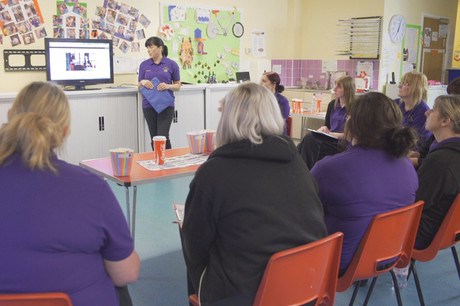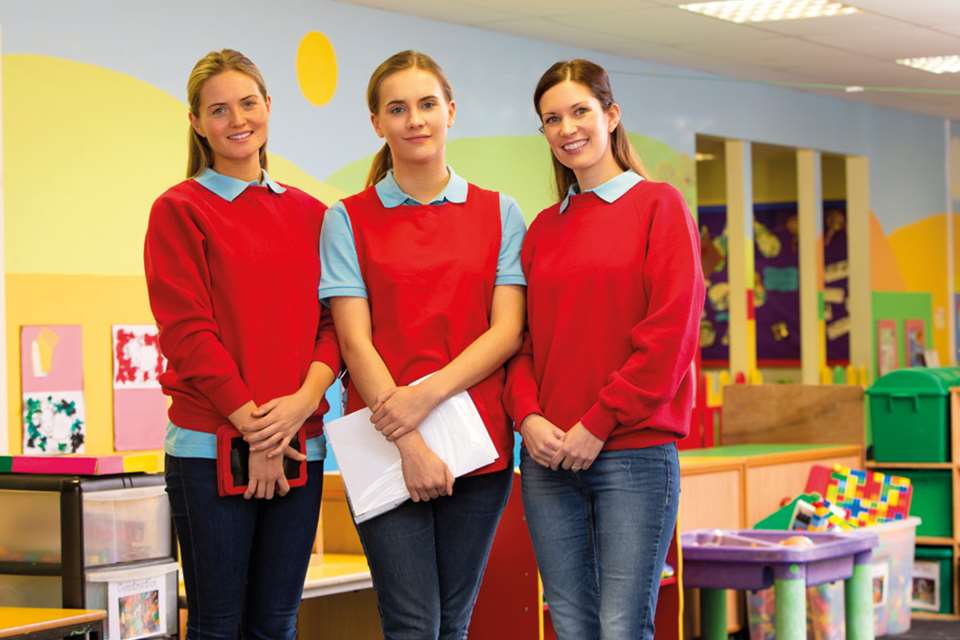Training Today: Continuing Professional Development - DIY training
Nicole Weinstein
Monday, July 11, 2016
In these budget-straitened times, finding quality training for free and sharing it among colleagues are skills worth developing. But how do you cascade training effectively? Nicole Weinstein finds out

Gone are the days when settings were able to access free-of-charge or heavily subsidised training – and in some cases, money to cover the absent member of staff – from the local authority. Now, councils only have a statutory duty to support settings that ‘require improvement’ or are ‘inadequate’. The onus is on providers to fund their own training.
‘Settings are having to think creatively about how to provide staff with CPD in the wake of the changes,’ explains Sue Overton of Soap Media, who writes and produces films to facilitate training in the sector. ‘The impact to providers is becoming more and more apparent. Some councils are creating training hubs where providers have to pay training costs. It is quite worrying as there is such a squeeze financially already on the sector, and now the availability of training support is being restricted.’
Changes mean that new training providers, without a proven track record, are popping up to tender for this training, says Francesca Cornwall, lecturer in Early Childhood Studies at Staffordshire University. She says, ‘It’s become a business whereas before it was about raising standards. Many web-based companies offer cheap alternatives for staff training and cash-strapped settings are naturally opting for this.’ Ms Cornwall, who has worked in early years for ten years and was quality and training manager at the Outstanding Teddy’s Garden, says that now, ‘Many settings are using their EYTs and graduates to produce and offer in-house training or conduct their own mock Ofsteds.’
CASCADING TRAINING
What does a DIY approach mean in practice? Settings are often told that one way to save money is to send one member of staff on a training session who then ‘cascades’ the training – shares the information with the team. The attraction of this method is obvious: save money and staff time by sending one member of staff on a training course instead of ten. But there are obvious problems. Standard management theory suggests that 25 per cent of the original message is lost with each new dissemination – and that’s with a competent delivery.
Judith Dancer early years author and trainer, says, ‘A dear colleague of mine once said to me, “The problem with cascading training is, it often ends in muddy pools.” As an ex-national trainer, who used the cascade model with varying degrees of effectiveness, I know exactly what she meant – we all need to find ways to share new expertise and training, while avoiding those muddy pools of confusion and lack of depth.’
Kim Benham, senior manager of Sparkles Pre-School in Croydon, rarely sends individuals on training because of the difficulties in cascading the information. She says, ‘It has worked on some occasions when the practitioner is strong, but there are many issues involving time and paperwork. I find that a one-day full staff training session a year, combined with one-to-one tailored training when needed, is the most effective way to engage the team. It’s also more cost-effective because the nursery closes for an inset day.’
Nikki Batt, manager at Kidzone Cranwell, agrees. ‘I’ve got graduates working in every room. Yes, they have the knowledge of early years and childcare and the EYFS. Yes, as individual practitioners with their own key children, they are fantastic. But they are not teachers, and I am really struggling with how to harness their knowledge and pass it to others. Some of them are just not confident enough to pull people up on areas of good practice. As yet, we have no definitive answer to the training challenges that we are faced with.’
TIPS FOR EFFECTIVE CASCADING
Experts agree that cascading well depends on the quality and understanding of the staff going on the training, being able to set aside time to disseminate information, and leaving staff with a clear message.
Ms Dancer says, ‘It is great if two colleagues can attend training together, with a clear brief of sharing key findings with colleagues.
‘Managers and leaders need to accept that information shared by practitioners will not be the same as training delivered by experienced trainers with in-depth knowledge of a subject – even from a ‘train the trainer’ event with handouts provided. Ten or 12 key points with a few possible points for action (to be agreed with managers beforehand) are more useful than a garbled account of a day’s training.’
Liz Richardson, who heads a dedicated training division, says that where the quality of the team is already high and there is a culture of continuous improvement, staff are ‘more likely to be receptive to new messages and information from training.
‘Where quality is poor and the hope is that the training will support real change in the nursery or practice then it will be important to send as many people of as senior a level as is possible if the whole team can’t be trained.’
She adds that cascading can be ‘very difficult’ and that whole staff training or whole team (babies, etc) is the most effective. It can sometimes be done in staff meetings or training days.
Other methods of in-house training don’t have to require going on a course. Ms Cornwall, who has led a team of staff in achieving and maintaining Outstanding Ofsted judgements since 2008, says she conducted mock Ofsted inspections, led peer observations, and contributed to quality assurance by ensuring that planning, environments and staff-child interactions are responsive to staff skills.
She says, ‘I fully endorse the use of a mentor in the workplace for staff’, adding that having a partnership between student and mentor helps people get into a habit of learning from each other. It helps staff ‘recognise the positive input which students can make to the early years setting and allows them to maximise their contribution, learning from each other with EYT standards in mind. This also role-models an ongoing commitment to improvement, reflective practice, and maintaining high standards.’
She adds, ‘It is important that staff highlight their own weaknesses, or areas they’d like to improve, and therefore you can ensure that the training will work properly as training is learner-led.’
HOW TO ACCESS QUALITY TRAINING
There is a host of ways to access training, depending on the needs of the team and the most appropriate ways to deliver it, whether face-to-face or online.
Cuts to in-house quality improvement teams at councils means lots of trainers and training organisations are springing up.
Ms Richardson says, ‘Go by word-of-mouth recommendation or choose people with a track record or good credentials. Trainers recognised by the Nursery World Awards and other sector awards are a good starting point.’
Ms Cornwall recommends using trainers whose qualifications and publications can be tracked, and those who are endorsed and used by leading professional bodies in the sector such as National Early Years Trainers and Consultants (NEyTCO).
ONLINE TRAINING
When looking for effective online early years training, it is important to ensure that you are accessing training designed and delivered by experts in the field.
Ms Stevens says, ‘The National Centre for Excellence in the Teaching of Mathematics has a history of quality assurance in the field of face-to-face training and they have some free online modules. You do have to register, but it is free, and unlike some providers they do not bombard you with unsolicited emails and “offers” of paid-for training.’
CPD is not just about formal training, explains Ms Benham. ‘There are a lot of valuable free resources available online. We sign up to Early Years Podcasts, which are half-an-hour sessions on issues around safeguarding or good practice. I often give staff a weblink and a review form and their thoughts are fed back in staff meetings. The same goes for free webinars, such as Early Years Investigations, and Twitter accounts, like @EYtalking and @NEYTCO, which often have good links to trainers and research. There are also Early Years chats on Twitter some evenings, which some of my staff have joined.
‘We look at lots of different sources to implement our changes, and these networking opportunities as examples of CPD have been recognised in our recent Ofsted report.’ Another example is a gardening project which used ideas from a website to make a ‘jungle’ for dinosaurs.
MORE INFORMATION
www.nurseryworld.co.uk/careers
www.pre-school.org.uk/free-educare-training
www.open.edu/openlearn/body-mind/childhood-youth/early-years
Creative gardening ideas can be found at www.creativestarlearning.co.uk
Sue Overton, Soap Media, www.soap.media
Acorn Childcare, https://www.acornchildcare.co.uk
www.kidzonecranwell.co.uk/index.html
Statutory guidance for LAs
As from March 2016, local authorities only have a statutory duty to support settings that ‘require improvement’ or are ‘inadequate’.
See Part D of the following guide – about councils having to provide training and info to those judged less than Good: https://consult.education.gov.uk/early-years-funding/childcare-free-entitlement/supporting_documents/STAT%20GUIDANCE%20latest.pdf







